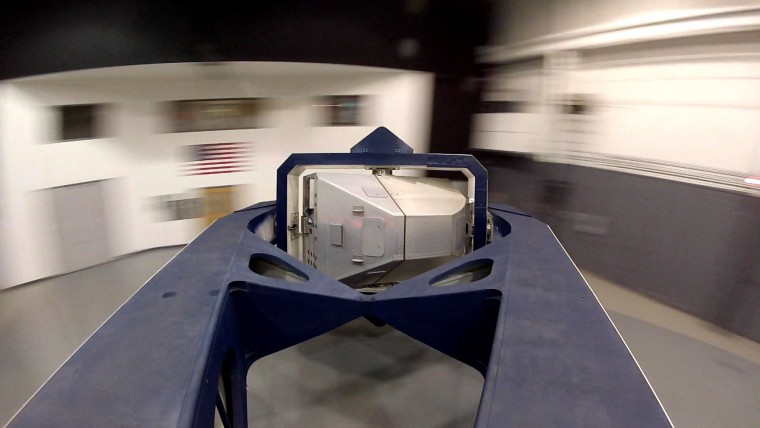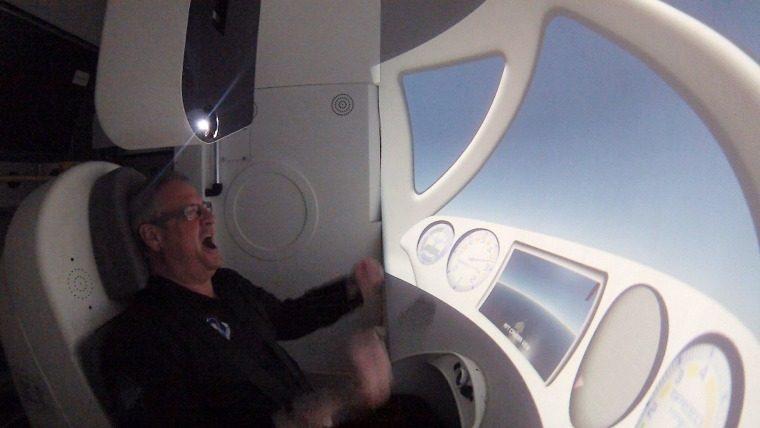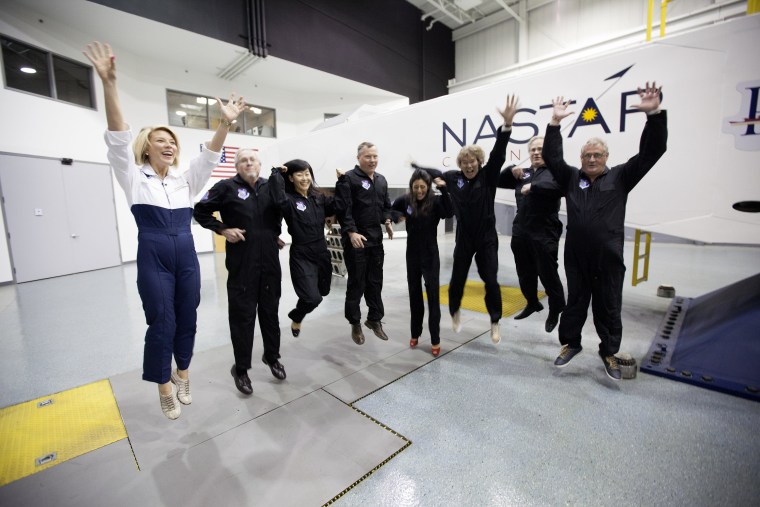SOUTHAMPTON, Pa. — What does it feel like to blast off into outer space? It's been compared to a kick in the pants, or an elephant sitting on your chest, or a sudden lurch on the elevator. When you take a simulated ride on the SpaceShipTwo rocket plane, you find out it's all of the above.
"Haven't had so much fun with my pants on in years!" said Ian Bailey, a business executive from New Zealand who came to the NASTAR Center here to sample the acceleration of spaceflight at the end of a 25-foot-long centrifuge arm.
Bailey is among dozens of would-be spacefliers who made reservations on Virgin Galactic's SpaceShipTwo rocket plane — and have paid a little extra for an early taste of the experience they're looking forward to in the years ahead.
SpaceShipTwo is currently going through flight tests, and commercial service is expected to begin within a year. More than 700 customers have signed up so far. It costs $250,000 to buy a ticket to go into outer space, reaching an altitude as high as 62 miles (100 kilometers). The cost of going through NASTAR's two-day training program, rooted firmly to the ground near Philadelphia, is $3,000.
Why do it? "It's the closest thing on earth to the actual spaceflight," said Brienna Henwood, who is NASTAR's director of space training and research — and our trainer for a centrifuge session last month. Virgin Galactic doesn't require the training, but it's a way for future astronauts (and the occasional journalist) to experience the thrills they've signed up for while they're waiting for the real thing.
It also helps future fliers learn how to deal with the physical challenges posed by spaceflight. If you're paying a quarter-million dollars for a rocket-powered blast into space, you don't want to spend the crucial minutes of the experience being sick or semi-conscious.
"This is the most important thing I'll ever do in my life," said Craig Willan, a 60-year-old aerospace engineer from Texas who's No. 8 on Virgin Galactic's list of signups, "and I'm going to plan this thing down to a gnat's ass."

Getting into the swing
The centerpiece of the center's course is the centrifuge — a massive metal arm that swings around its axis with an enclosed capsule at the end. Once NASTAR's controllers get you strapped inside the capsule, light up the big-screen displays going and rev up the motors, they can twist and turn you to simulate any flight experience. Depending on how the capsule is oriented, you can even get a zero-G feeling.
NASTAR's facility in a Philadelphia suburb has an assortment of centrifuges, ejection seats and other equipment for training jet pilots, and that still accounts for the bulk of its business. It's only been within the past decade that the company has been taking on civilian spacefliers-to-be as well.
"This is the most important thing I'll ever do in my life, and I'm going to plan this thing down to a gnat's ass."
In the classroom, Henwood explained that fighter jocks — and SpaceShipTwo's passengers — have to deal with two different types of rapid acceleration. One kind of force pushes you back in your seat, like the feeling you get when a roller coaster races down a track. That's called Gx ("gee-ex") because it pushes along the x-axis you learned about in algebra class.
The other force pushes you down, like the feeling you get when a high-speed elevator suddenly starts going up, or stops going down. That's called Gz ("gee-zee"), because it works along the z-axis. Gz is the one that causes the most trouble, because it pushes the blood down from your brain.
In extreme cases, the Gz force can cause fliers to lose consciousness. And the forces encountered on SpaceShipTwo — in the range of 3.5 G's, or 3.5 times the normal pull of Earth's gravity — could cause you to lose peripheral vision, or even black out if you're not careful.
To counter the Gz force, Henwood taught a technique called the anti-G straining maneuver, or AGSM. One part of the maneuver involves tensing the muscles of the legs, arms and abdomen, to counter the downward push of blood from the brain. Another part involves taking sharp, cyclic breaths, saying "hook" on the outtake.
As we practiced our breathing in the classroom, we sounded like expectant moms getting ready for natural childbirth. Henwood told us to put more force into the exercise. "There have been a lot of polite 'hookers,' and I mean that in the best sense of the word," she joked.
Then it was time to hook ourselves into the centrifuge.
A roller coaster on steroids
For the next day and a half, we took turns climbing into the STS-400 centrifuge's capsule and going on simulated flights. At first, the ride gave us half the G's that would be experienced on SpaceShipTwo. Then we worked our way up to the full profile: 3.5 Gx and 3.5 Gz for blastoff, zero G in the middle, and then an elephant-sized push of 6 Gx on the way down.
The numbers don't really give you a sense of what it feels like. Bailey described it better after he took a few turns. "A roller coaster on steroids ... it's just like a huge roller coaster, but very intense. And actually a lot of fun," he said.
The ride was no big deal for one of Henwood's students, but he had an unfair advantage. The "student" was Todd Ericson, an Air Force test pilot. Ericson, who has been trained to handle 9 G's of acceleration, hammed it up when it was his turn.
"Ah, that feels good," he said. "Got my back all cracked."

One trainee giggled most of the way through the flight — but Xin Liu, a Chinese-American journalist and philanthropist who is No. 188 on Virgin Galactic's list, had a more serious time of it.
"I feel like my face is being pulled down," she said during the simulated blastoff. Her peripheral vision started to go, but a few "hook" breaths brought things back to normal.
"I wish I could wear a pair of glasses like this: space glasses," she said.
My vision also seemed to fade when I took my first turn in the centrifuge. After that, I made sure to tense my muscles and shout out my "hooks" when the Gz hit its peak. Maybe I overdid it: After I finished my last turn, the rest of the class informed me that my new nickname was "Doctor Hook."
The Gx part of the flight was weird in a different way: Although some have compared it to an elephant sitting on your chest, to me it felt as if an elephant was popping out of my chest, "Alien"-style.
The experience had a profound effect on Willan, who has been waiting nine years and counting for his spaceflight. The big-screen view of star-filled sky above and Earth below was merely computer-generated, but it still brought tears to his eyes.
"I'm speechless," he said, "and for me, that says something."

After the centrifuge was shut down, after all the pictures were taken, after all the certificates were handed out, the spacefliers-to-be were still anxious for more. "I should come back each year, at least do it once a year before my actual flight, just to condition my body and also refresh the memory," Liu said.
Some of the feedback from the training is already being factored into Virgin Galactic's plans for the real-life space experience. For example, the seats on SpaceShipTwo will be equipped with footrests for passengers to push against when they clench the muscles in their legs.
Virgin Galactic is also looking into ways to let passengers listen to their favorite tunes during the flight, perhaps over custom-designed headsets — as well as methods to match up passengers with similar interests, so that the ones who want to roam around in zero-G don't spoil the experience for more meditative types like Willan.
"My nose is going to be pressed to the porthole, and I want to see the big blue ball," Willan said. "That's very, very special to me."
Even Ericson, the test pilot who jokingly yawned his way through 6 G's, got something out of the experience.
"It's going to be a good kick in the pants," he said, "and it just keeps going."
NBCUniversal has established a multi-platform partnership with Virgin Galactic to track the development of SpaceShipTwo and televise Virgin founder Richard Branson's spaceflight.